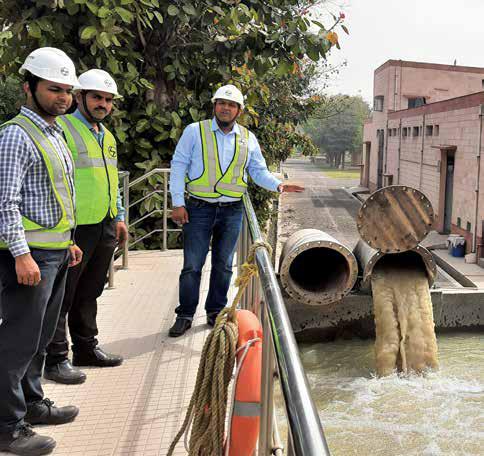WET IC keeps Delhi’s drinking water safe despite the Uttarakhand glacier break
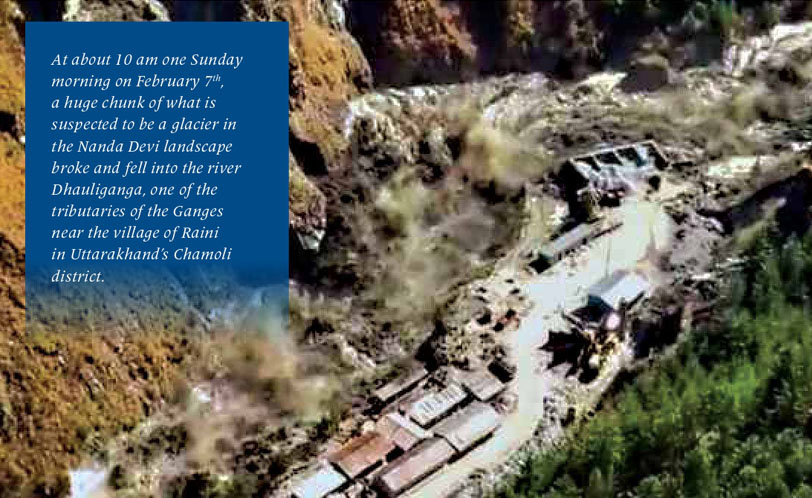
Who would have ever imagined that such a natural calamity high up in the Himalayas would have a severe adverse impact on the drinking water needs of the national capital, located several hundred kilometres away! As the flash flood swept down the mountain taking all with it, the turbidity (the presence of suspended particulates – debris, silt, algae, plants, sawdust, wood ashes, chemicals) of the water in the Upper Ganga Canal, which is one of the main sources of Delhi’s drinking water, rose alarmingly. Against the normal seasonal turbidity levels of around 25–50 NTU (Nephelometric Turbidity Units) and a permissible level of 100 NTU, the raw water reaching the L&T‑built 110 MGD Bhagirathi Water Treatment Plant, one of Delhi’s largest WTPs, was around 3,300 NTU by the 13th that increased to 8,200 NTU the next day and even higher thereafter. The client, Delhi Jal Board (DJB), suggested drawing water from the river Yamuna to maintain plant production. However, the water in the Yamuna carried high levels of pollutants like ammonia at 1.2 to 1.9 PPM levels that had to be diluted.
Preparing for the challenge
Even as households across South, East & North East Delhi started to experience disruptions in their water supply by the 13th, the challenge before L&T’s Project Head, Ravinder Singh and his team at Bhagirathi was to maintain plant production. “We quickly reviewed our chemical stock and lined up the treatment process as the turbidity began to increase. All maintenance works were put on hold.” Getting the right chemical mix was crucial to the treatment process and in this scenario, it was even more challenging, indicates Santosh Kumar, Chemical In-charge, “Around 1 lakh litres of Ferric Alum solution was prepared anticipating a rise in turbidity while all standby PAC tanks at the clarifiers were filled to their maximum for the chemicals to be gravity fed in case the dosing systems failed. This ensured that the plant activities remained normal, and the outlet water quality was as per safety standards.”

Marrying the waters of the Ganga & Yamuna
On 14th February, the turbidity crossed 7000 NTU, recalls Ravinder, “It was an alarming situation as all the bar screens started to choke and despite frequently cleaning the settlements and deposition of silt, the risk of plant operations stalling was high.” They decided to cut the raw water output by 30% and lift raw water from the Yamuna as per the client’s direction. However, there was still a lot to be done from the processing point of view as Santosh mentions and immediately confirmed the status of pollutants to the Delhi Jal Board Chemist which was 5 times more than their treatment capacity.
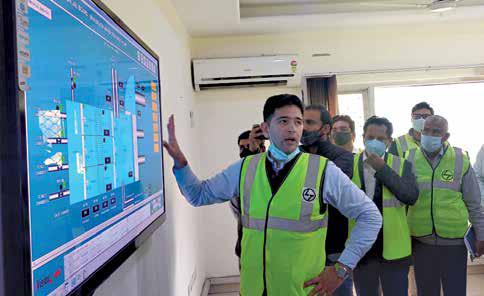
Mr. Raghav Chadha Honorable Vice Chairman Delhi Jal Board explaining plant status to the media along with Chief Engineer
Mr. M K Hans, Executive Engineer, Mr. S P Gautam and other DJB officials.

The task before us was to marry the waters of the Ganga and the Yamuna ensuring that the proportions were just right in the 2:1 ratio.
Ravinder Singh
Project Head
“The task before us was to marry the waters of the Ganga and the Yamuna,” remarks Ravinder, grimly, “ensuring that the proportions were just right in the 2:1 ratio,” fully aware that any error in his calculations could result in several parts of Delhi going without clean drinking water.
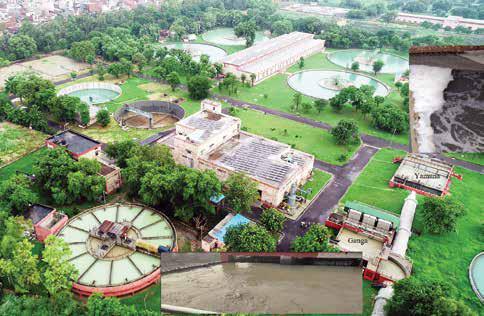
Overview of the plant with the Ganga and Yamuna inlet channels
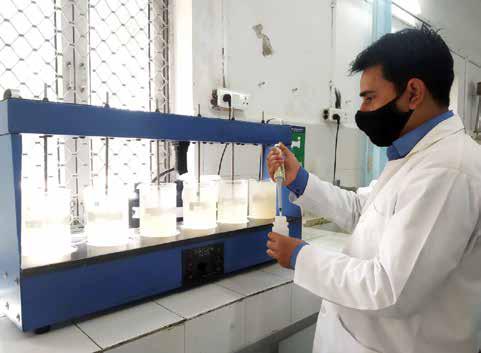
Arriving at the right solution
Taking the challenge head on, the team worked out a practical and secure approach with spot chemical dosing as the raw waters were mixing largely inside closed conduits with only minor surface areas available for assessment. “As all the inlet channels of the clarifiers had different raw water characteristics, it was very clear that one single dosage would not work,” points out Himanshu Bhardwaj, O&M Head. While the jar test was a convenient mode to assess the optimum chemical dosage, it was a time-consuming process, so the team used it only at intervals to check on the dosage while relying on the available data that was further ratified through samples sourced from flash mixtures, floc formation to arrive at the right dosage.
“We had to think on their feet,” Santosh remarks. “For instance, when the jar tests indicated a higher variance across any of the channels, we had to accordingly align the dosage, which continued till the turbidity returned to normalcy over the next couple of days.” The outlet parameters were secured with additional chemicals prepared and maintained as per the dosages derived from the jar tests. Some of the initiatives that facilitated the process included transferring excess concentration of sludge to additional sludge drying beds instead of putting it through a further thickening process. The effectiveness of the chemical dosage was closely monitored to maintain the consistency of the treated water turbidity within 1.0 NTU.

We had to think on our feet for instance, when the jar tests indicated a higher variance across any of the channels, we had to accordingly align the dosage, which continued till the turbidity returned to normalcy over the next couple of days.
Santosh Kumar
Chemical In-charge
Fulfilling a vital mission
The efforts bore fruit as DJB proudly declared in the media on February 16th that production at the Bhagirathi Water Treatment Plant was back to 100%, appreciating the collective efforts of the WET IC O&M team to speedily restore Delhi’s drinking water supply.
Ravinder Singh is thankful for the enormous and timely support of his teammates: Himanshu Bhardwaj, Santosh Kumar, Paramjeet, Sourav Sain, Varathan, Chiranjit Ghosh, Santhosh S., the guidance, extending of resources by WET IC — O&M BU, Regional In-charge Santhakumar R and Aher Vijaykumar Shivram to save their client some blushes and achieve their objective of ensuring that Delhi kept drinking clean water, despite the Chamoli disaster.
